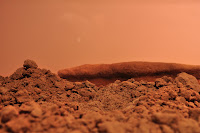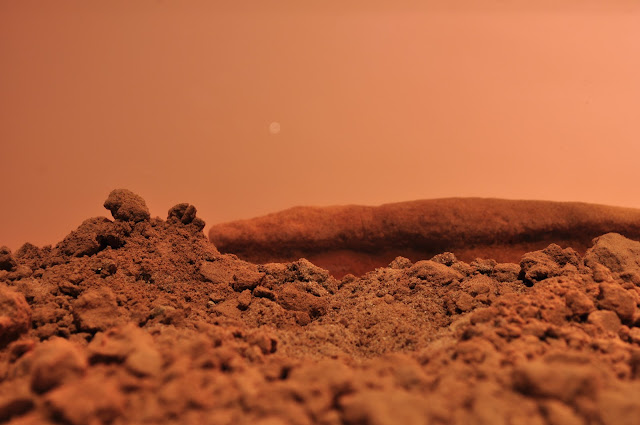Monday afternoon I went out the banks of the Brazos river and collected some dirt for the Mars landscape. I felt it had the best texture and closest color to Mars, and with a bit of color gel on the lights it would look like Mars.
Thursday night I started the molds of the rock. I didn't think I would use the mold's for the mars display but knew I probably would for the other planets that had more of a rocky landscape. So I wanted to go ahead and test the molds and see how they would hold up and look in and out of water. After leaving them overnight, I came in Friday night to check the molds. The large molds ripped a hole in the large rock one, but I think I can still reuse the mold with a bit of duct tape fix. I clean the molds up by shaving excess down.
Saturday morning I went to buy paint, since earlier in the week hobby lobby was out of it. Fortunately the new shipment came in, so I got it and picked up some scrap cardboard to act as a base for the foreground for Mars. I spray painted the rocks, and took them back up to the studio space due to bad weather to let them dry.
For my setup I used combination of foam and cardboard to act as a base for the foreground of the landscape.
My Setup
Atmosphere
This was my first run through of doing a landscape with this set up and I learned alot to help prep me for the next photoshoot. One of the first things I experimented with was atmospheric look. The first image is with just clear pure water, and the second image is with dirt/clay in the water. I believe I added too much dirt this time around, so the next round I plan on using much less, but I don't want to leave the water clear, I believe the dirt in the water
added more depth to the scene.
 |
| Clear Water |
|
 |
| Water with dirt |
|
Lighting
Next I experimented with the lighting. I realized I need more lights. I'm trying to keep my light limit down since it's very dangerous having lights near a water tanks. So for the next round I plan on using 1 v light at the far corner in the room away from the tank with heavy sand bags to help light the foreground, then use the desk lamp to light the water. Overall I'm trying to get a soft diffuse light for the landscape so it's not stylized and looks more natural to the environment.
Composition
Composition is where I needed the most work on, and 2 major issues I ran into. One was the atmosphere, there was too much dirt in the water so it was hard to see the silhouette in the background since the water was too muddy. Because of that, I couldn't push the rock that much back without it completely disappearing as well. It takes about 40 minutes to completely empty the tank and clean it out, so I ran out of time to experiment again, but lesson learned. Another issue was not having enough large rocks. I had too many small rocks that disappeared in the tank behind the dirt horizon, thus I couldn't get much depth. Sunday I paid another visit to the banks of the Brazos river and collected a large bucket full of rocks, mostly sandstone, petrified wood (good for silhouettes and other planet landscapes) and some sort of brown jade-ish rock.
Result & Future Plan
Out of this series, I believe this was the most successful image. But I am not done with Mars. I plan on doing another shoot of Mars with the lessons I learned from the first shoot. My main focus is to get a better landscape of Mars down, which should be much easier to do with alot less dirt in the water and larger rocks to work with to build the set.









































